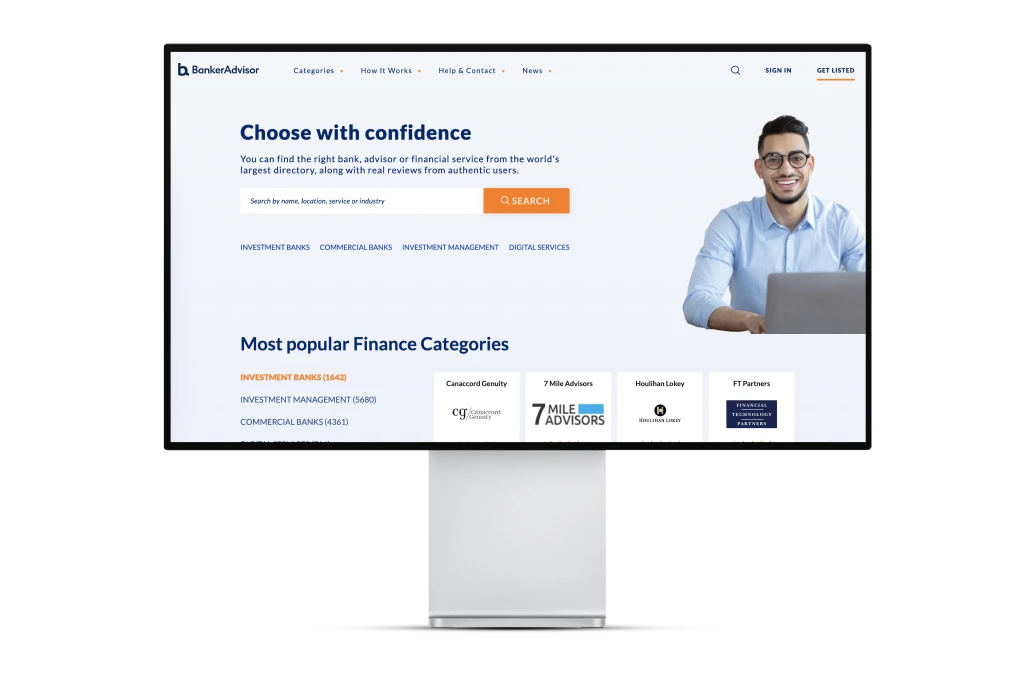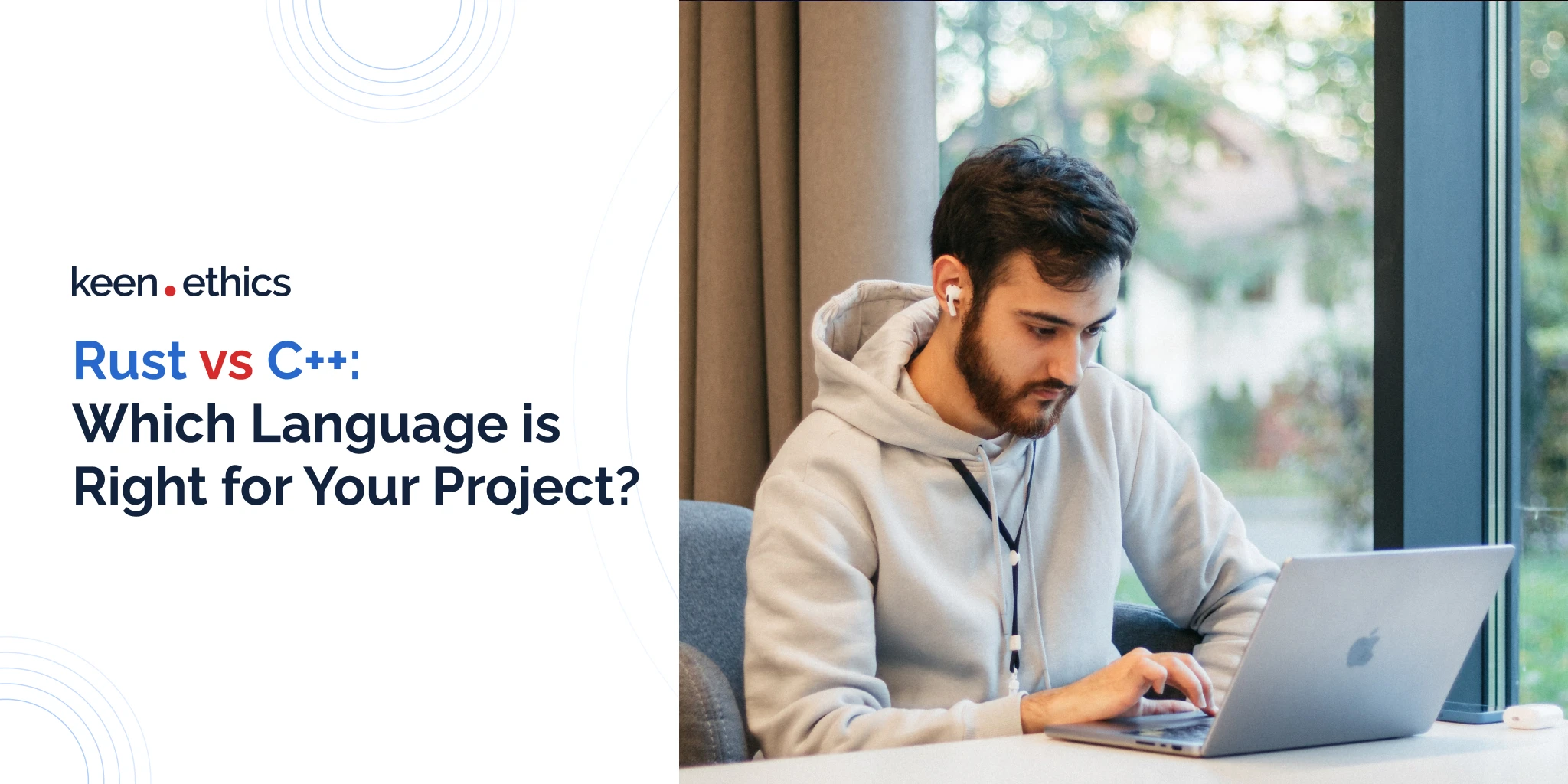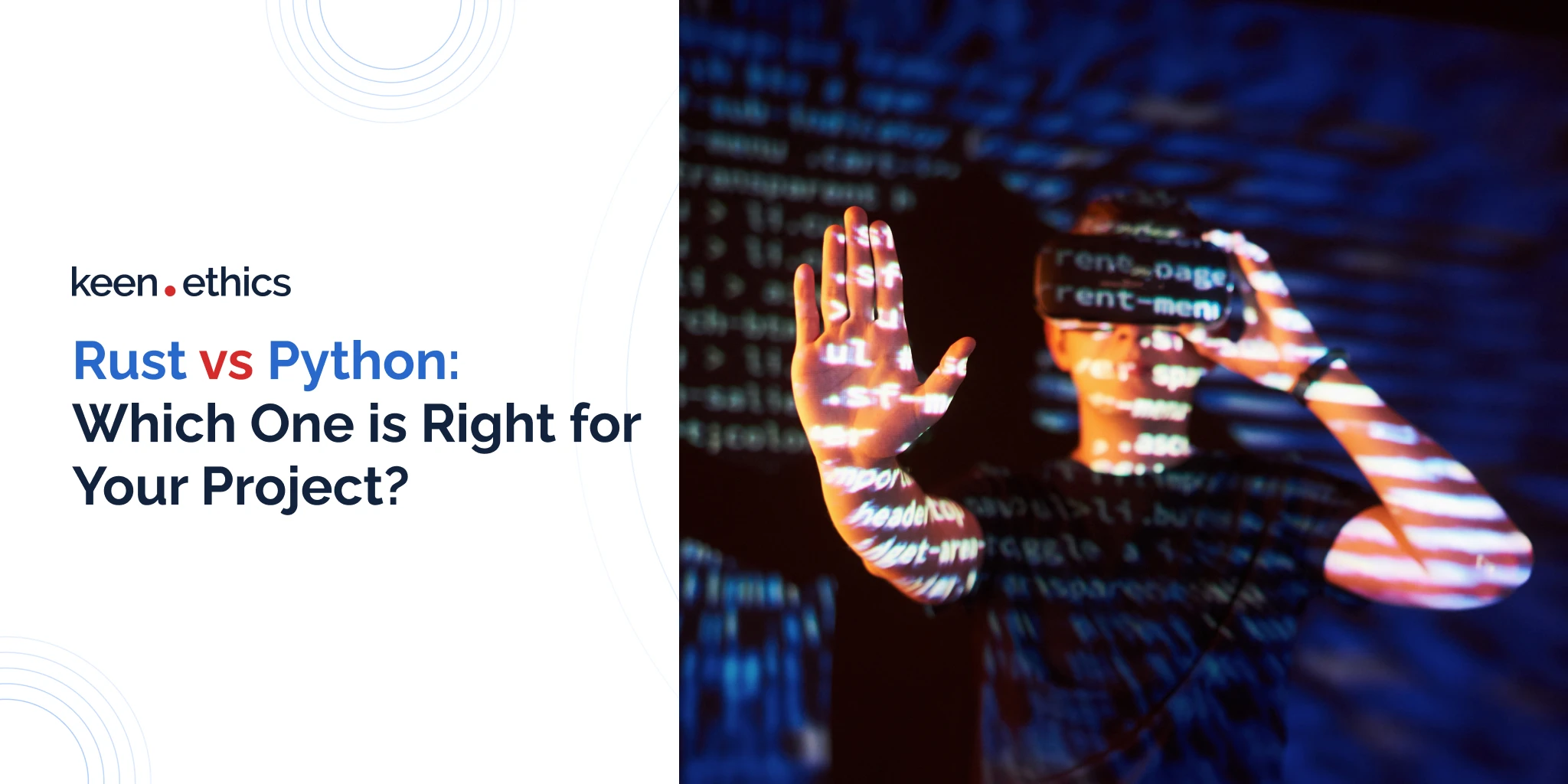Startup MVP can help many businesses avoid problems with experimental concepts
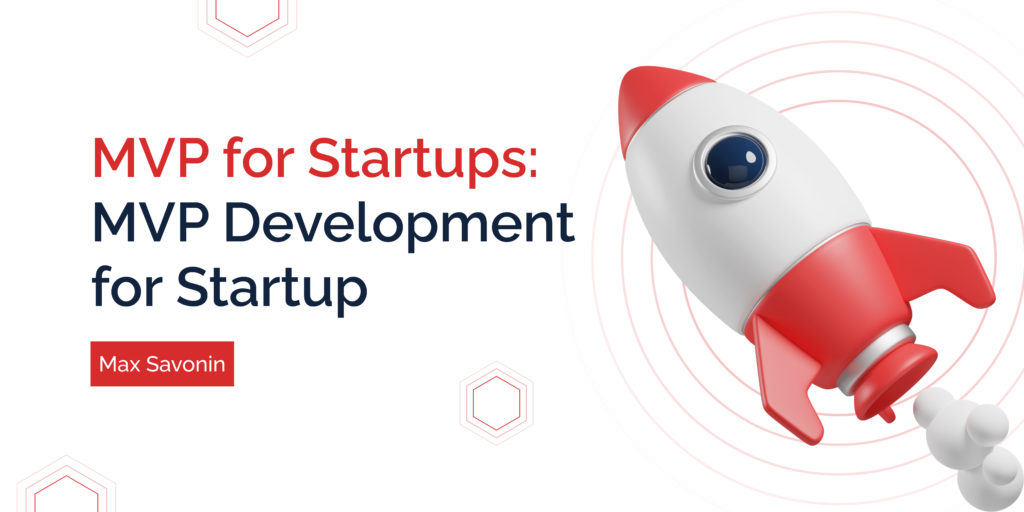
MVP for startups is a solution that solves many problems. The most crucial goal of any startup activity is saving costs. Many companies that begin working in business-related fields usually don’t have large financing. They operate on the personal funds of creators and some venture capital. The costs of failure, in such cases, are likely to be devastating. If you can’t find potential users, it’s very likely that unpleasant procedures such as official bankruptcy can happen to you. Startup MVP can help many businesses avoid problems with experimental concepts. In this article, we’ll look at its key features and describe the potential steps you should take to create an efficient MVP. With this insight, you’ll have more resources to ensure the long-term stability of your business.
What is MVP in a startup?
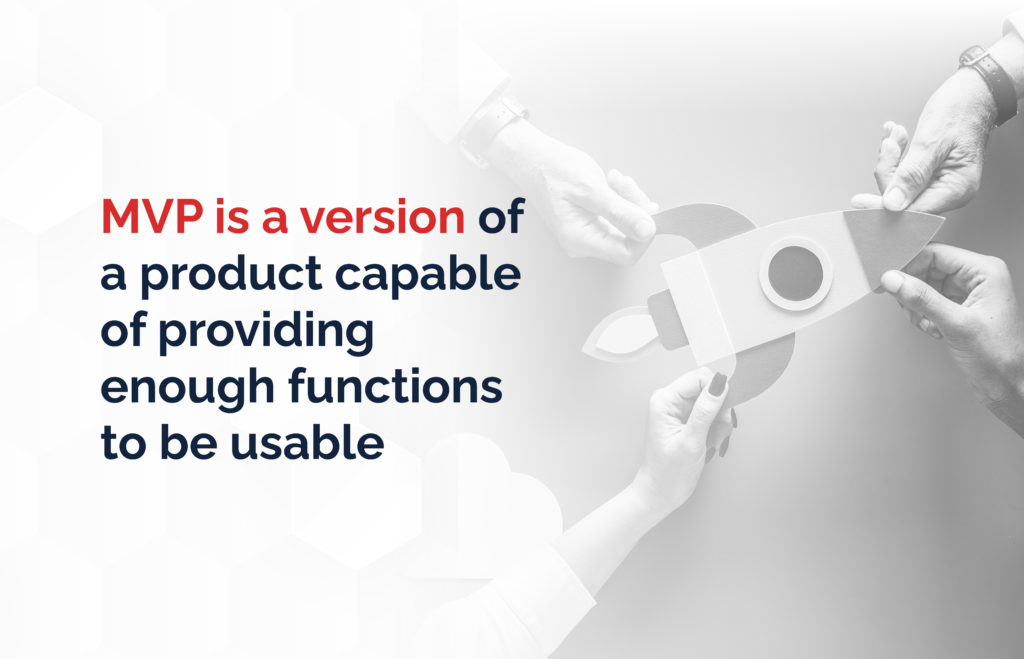
MVP startup meaning has a simple explanation: it stands for the concept of the so-called minimum viable product. Most likely, the title of the concept already tells much to you: MVP is a version of a product capable of providing enough functions to be usable. Simultaneously, it isn’t as polished as the final version. What’s so important about the approach? MVP is a version of your product that has the key features but doesn’t require investments that will be necessary for a full-scale launch. Obviously, such an approach can save you a lot of time and funds.
What Is an MVP Development for Startup
MVP development for startup companies signifies procedures aimed at delivering a functioning version of your main concept. We’ll describe the main steps that you should consider later in this text. Nonetheless, the existing experience allows saying that startup MVP development is much more complex than it may seem. MVP development companies can offer you a full-scale software product, indeed. However, it’s also possible that the developers may try alternative ways (for instance, email lists or some form of blog websites) to test whether the basic assumptions of your business idea make sense. MVP development for startups aims at the target market rather than a product that fully resembles the intended end result. You are after the viability of the concept and not its optimal manifestation.
MVP Development Cost (Spoiler: Price Depends on the Project Complexity)
To be honest, making a prediction of the MVP development costs is difficult without input on your project. Different types of software or product may require divergent approaches. However, there’s one important unchanging factor about the startup MVP development. The main feature of such development lies in the fact that it’s definitely going to be cheaper than creating a full-scale product. The MVP development cost for something big and ambitious can be in the millions range but the full-scale product can demand tens if not hundreds of millions of dollars. We think that many individuals who work in business should immediately feel how many positives such an approach can bring about. In a situation when you can spend tremendous sums on developing something unknown, MVP presents the key functions at relatively low costs and offers user feedback.
The main goals of an MVP
MVP has a clear goal behind its creation. The main reason for the establishment of such a framework is the need to test product efficiency and its importance for the user base.
One of the biggest problems for a large number of projects is that they seem good on paper due to some unique experiences of the relevant individuals.
MVP for startups does an important thing: it helps a company to see whether an idea is actually of interest to someone apart from the creators. This practice is a de facto sanity check. After all, not every idea that seems to be good can function either because it’s too expensive or simply doesn’t have an appeal initially intended by the inventor. MVP seeks to defend your funds from projects that appear interesting but don’t have value in reality.
How your startup can benefit from an MVP
We’ve already mentioned one of the main reasons to utilize an MVP for a startup. Let’s take a look at some specific benefits of the approach. As you’ll see, multiple reasons exist to utilize MVPs.
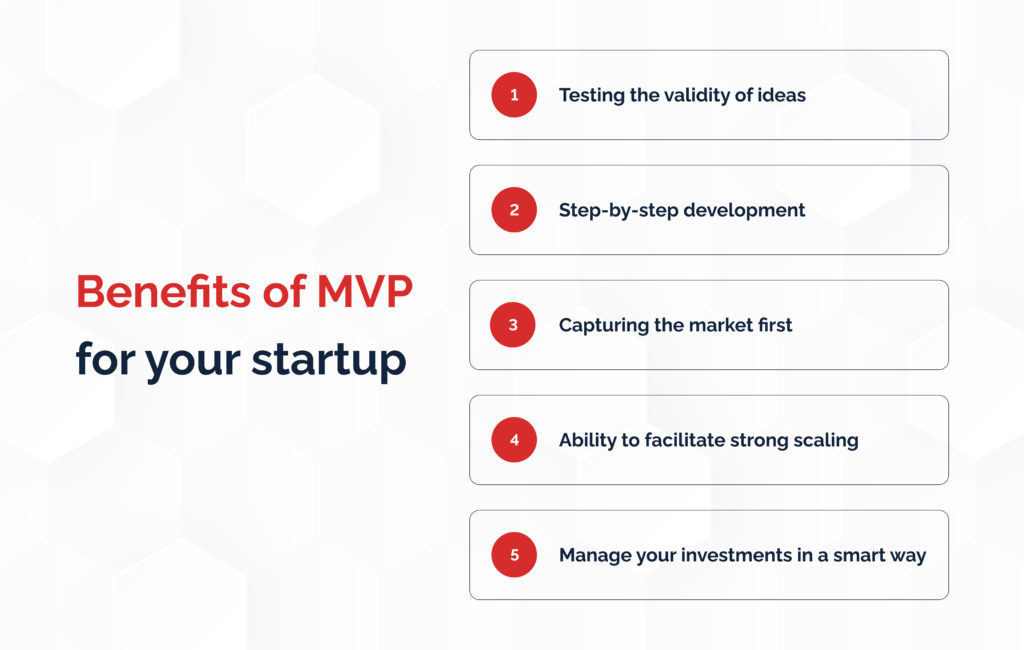
Testing the validity of ideas
We’ve already mentioned this factor, but let’s say it again: MVP helps you see whether an idea is ‘sane.’ It allows you to validate your market-related intuition about certain products. Companies without MVPs often spend tremendous funds on horrible ideas. You have to first understand whether potential customers would at all be interested in proceeding with your project.
Step-by-step development
We’ve mentioned that MVP defends you against bad ideas in development. The reality of modern business is that many ideas are not necessarily bad. What makes them problematic is the lack of improvement. Some startups fail only to become the precursors of larger and more successful products. One of the greatest examples of this manifestation includes the story of Vine and TikTok, two platforms based on short videos. Seven to nine years ago, you could find many interesting channels associated with the former platform. Many comedians, for instance, started to post their content there. Where’s it now, however? Few active users post something to Vine because its video length is too short (6 seconds). TikTok is also about short content but it allows creating videos for up to five minutes, giving more space for creativity. The lack of full-scale changes for Vine ended the platform. Step-by-step approaches promoted by building MVP for startups are the best choice. With this method, you can gradually remove development errors and create a refined product.
Capturing the market first
Many great ideas are usually a result of some new technology. For instance, NFTs are likely to inspire many people to create similar startups. In such conditions, the quality of the service would play a lesser role. What would be of value is the presence of a high level of attention. Active users can save the platform and create a chain reaction in which many people would be willing to use a potentially inferior or simply mediocre platform because of its popularity.
Let’s look at Windows, macOS, and Linux. Windows has many security and customization flaws compared to the two latter platforms. Nonetheless, it’s much more widespread. The reason lies in it being one of the first to capture the market. If you create MVP for startups, they can give you an opportunity to present some original approach to product usage first. As a result, you would gain a critical user base that would push the potential competitors out of the market.
Ability to facilitate strong scaling
MVP startup provides a unique product that can attract the attention of many users. Through this capture of the market, it’s possible to scale your product and move it far beyond the original intent. For example, if you create some form of an RPG (videogame), you can later add strategy elements to it to attract more people. User feedback for a successful MVP can help transform your project into something new and brave. MVP opens the path towards the gradual transformation of your product into something greater.
Manage your investments in a smart way
Some of our readers may be investing in several projects simultaneously. For them, the ability to understand whether some project is worth their time is important. This knowledge can define how much they will dedicate to certain fields. MVP offers a perfect way to distinguish between great digital products and the ones that are mediocre. By giving funds for an MVP, an investor can both become a major person in the promotion of a certain big project and, at the same time, prevent the tremendous expenditures that go into the traditional cycle of development. MVP is a smart way to see whether your investments make sense from a financial standpoint.
Reasons Why Some MVPs for startups fail
Many MVPs fail due to the incorrect execution of their main principles. Many companies simply don’t understand what an MVP truly means in the business context. Here are some of the main reasons for the problems with the concept:
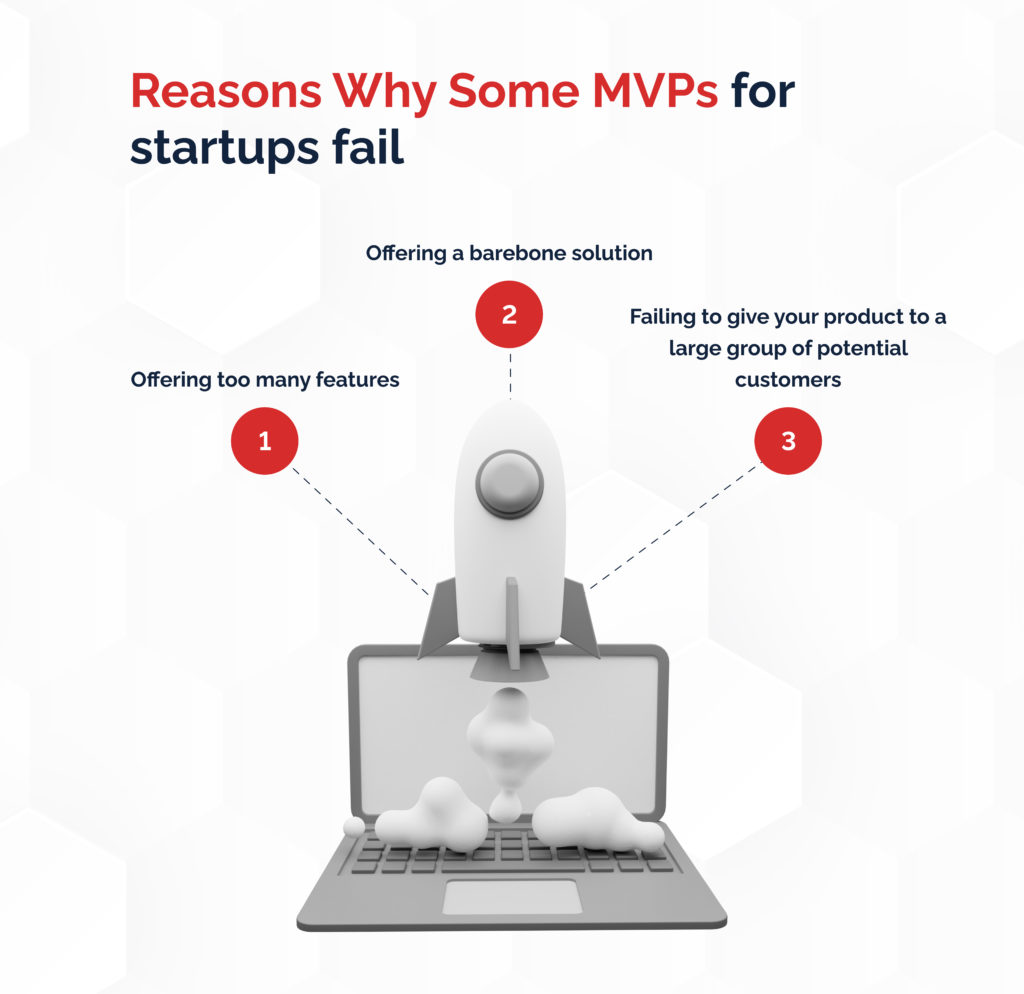
1) Offering too many features
Some companies believe that every feature they have in mind is essential for their project. In reality, nothing works that way. MVP startup definition involves a limited amount of functions that represent the key features of your business. If you make a social media website with a unique communication method, you should focus on what’s original rather than the features that are already present in other businesses.
2) Offering a barebone solution
The problem with this approach is that sometimes you may misjudge the overall needs of your key ideas. It may be difficult to promote a great customer experience if your unique idea is difficult to execute in real conditions. Don’t forget that your product also has to be viable: people should have no trouble applying its main functions conveniently.
3) Failing to give your product to a large group of potential customers
It’s not enough to create an MVP and test it on the development team. These people may be rather biased. The only way to guarantee that your test is valid is to invest in an analysis involving a full-scale focus on the target audience that you want to affect. In short, you have to release your product to the public instead of trying to create some overly closed groups.
A Full Guide to Creating an MVP for Startups
As we’ve promised, this guide will also touch upon the key ways to present an MVP for startups. Startup MVP meaning involves action: you should do many things to create a product that interests many people.
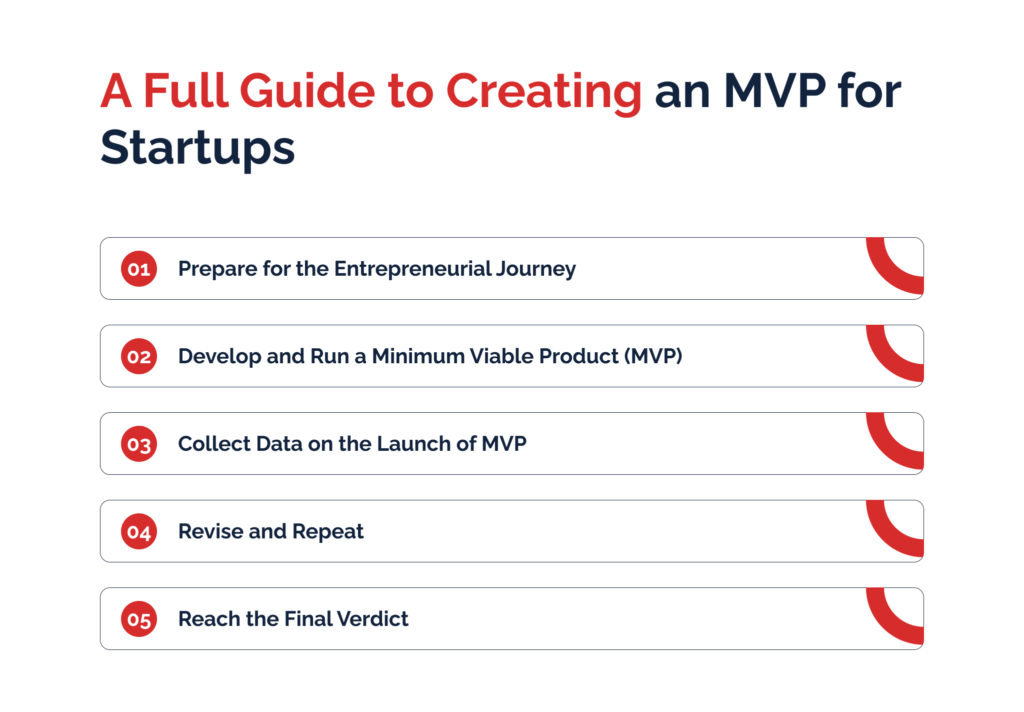
Step 1: Prepare for the Entrepreneurial Journey
Get Ready to Become an Entrepreneur
The first step before creating an MVP is becoming a full-scale entrepreneur. In practice, this means that you should focus on establishing good paperwork and resolving all of the key law-related issues. You must prepare everything to create a business fast. A lean startup must have the ability to deploy rapidly. Your preparation is essential for this goal: read some relevant theories and consult specialists to acquire the key skills.
Understand Your Idea
A big problem for many new investors is a lack of understanding regarding their proposed product. Many investors don’t have an idea how difficult certain aspects of development can be. In this regard, you should, above all realize the overall complexity of features. If you don’t have the relevant expertise, consult several professionals in your field. The more information you have, the better. Failure is inevitable when you don’t understand the product your company creates.
Create a Business Plan or a Lean Canvas
Once you clearly understand what type of product is in development and what’s generally necessary for it, you have to ensure that a definite deployment plan exists. Describe the key steps for the development of the product and imagine the key ways for its spread among potential users. Your business plan must answer every relevant question of the investors. Partners should know what you have in store for the promotion of a certain product.
Find Your Team
Once you have a clear understanding of the things you’ll do, it’s crucial to find the people who would be able to assist you. In this respect, try to find specialists who have some previous work experience in the fields that involve your type of software or product. One of the best options is to start searching for people ready to work with you during the initial stages that involve the idea creation. Advisors can be more than willing to access the development of your project. We especially recommend focusing on younger specialists as they usually tend to be more capable of taking significant risks: these people can see your project as a perfect opportunity.
Find an Investor
The most important aspect behind the creation of any business and MVP for it is the need to find some relevant funds. Obviously, they can come from your personal savings. Still, not all projects are sufficiently small to allow personal funding. More importantly, there’s always a risk to make a miscalculation and underestimate the spending scope. Your best option is to present a development budget to a set of potential benefactors who would then decide whether your project is worth their time. The better your team and plan are, the higher the chance of finding some strong deals.
Step 2: Develop and Run a Minimum Viable Product (MVP)
Once you have funds and a general structure of your business, it’s time for a full-scale MVP.
Understand the Concept of MVP for Startups
The first aspect you should consider is understanding MVP as a concept. Many people fail to realize what’s necessary for such an approach. So, what is MVP in startup? It’s a minimum viable product. Your product should have a minimal amount of features that can make it successful in the market. This article should give you many interesting insights on the topic.
Prepare for MVP Development
Another crucial step that you should focus on is ensuring that you’re ready for an MVP. Firstly, you must offer a theoretical explanation of the concept to the team. Everyone should understand the overall approach of the concept in order to prevent inefficient development activities. Secondly, you have to clearly define what features are of value to your product. It’s crucial to avoid the things that can be interesting but don’t highlight your unique contribution. There should be a development cost checklist to focus on the most efficient path.
Build an MVP
Once you’ve established clear parameters for your project, focus on its creation. When it comes to building an MVP, everything depends on the specialists you have. Here, we can make no special contributions. The development of MVP doesn’t differ from full-scale projects in terms of process. One of the key differences here is the scope of your ambitions.
Secure Your Idea
Once you have the full-scale MVP prototype, try it out with the key members of the team and some insider groups. Ensure that it works well and that the cohesion of the product is present. We advise against extensive internal testing, but it’s definitely necessary before you make a full-scale judgment on some product and decide to push it into a full-scale release. Involving your investors in this approach is a great idea.
Step 3: Collect Data on the Launch of MVP
Make Your MVP Public
This step is probably the simplest one on the list. Publish your project and make it available to a maximum number of outsiders. Here, you can create a full-scale website and leave the sign-in or download links.
Explain Your Idea to the Market
A crucial step in the development of MVPs is the need to tell people why they may require your project. Use some advertisements and attract various bloggers to the project. A set of interviews can be highly helpful in many cases too. In short, your goal is to act as a marketing specialist for the MVP. The concierge MVP approach is especially dependent on the approach: a proper explanation can help users understand that something bigger and more convenient is on the way.
Ask for Feedback
Make sure to establish a strong contact with the users. Create some forum where they can describe their experience and, more importantly, insert certain user surveys to understand the overall viability of the idea. The more people offer you input on a certain idea, the higher the chance that you’ll find weak points and disrupt them. The key reason for building MVP for startups is the focus on the information coming from potential customers.
Step 4: Revise and Repeat
Communicate With Your Users
You shouldn’t only focus on getting feedback about your project. Instead, it’s crucial to offer some things personally and target the users through active communication. Write in the forums and create videos about the MVP in question. Do everything to let people understand that you’re actively working on a project.
Keep Developing
Once you get the relevant feedback and know the main needs of the customers, don’t stop. People may start leaving if they see slow development. Instead, you should add new features and steadily turn your product into something novel. One of the best startup MVP examples, Facebook, used this model to become the biggest online platform in the world. Show that you listen to the users’ feedback and they’ll join you en masse.
Look for Better Sales Channels
Try to find better ways for spreading your product. Perhaps, it may find success on social media platforms or through the traditional Google advertisement. Experiment with diverging platforms to see what approach appears to be the most applicable. We also recommend considering the non-online fields. Many of them may involve something interesting if you, for example, aim at product promotion for some big business.
Watch the Market
Lastly, a big component of an MVP is analyzing market developments. Register how people react to your product. Look at the things that they may find lacking. The most dangerous thing for some businesses with an original idea lies in the appearance of alternative startups that seek to correct their errors. Startup MVP meaning allows overcoming this problem by giving you a strong reaction time. It’s possible to quickly add something new if your project is lean enough and counter the competition.
Step 5: Reach the Final Verdict
Once you’ve established an MVP and have enough feedback from the users (including the one connected to further update efforts), it’s time to make a judgment. Is it popular in the market? Are there any companies that do your job better? If the answer to the first question is yes and the other is no, then you can most definitely continue with a project. In case you see low interest, it’s easy to close it without facing losses that are devastating. Many of the further activities would be much easier to manage.
In Conclusion
To summarize, an MVP is a strong solution for all businesses that want to ensure their financial security. By creating an MVP, you can see if a certain idea works and then transition toward its implementation with a much bigger budget. We hope that this guide is of great value to you. Using it, you can create a viable MVP for any company.
Turn your startup idea into reality with our MVP development services. Get in touch with us and we will launch an MVP for your startup.
 Search
Search



